USS MULLINNIX DD-944
 1961
1961
Mediterranean 
Second Trip to "The Med" by Mullinnix
2 February 1961 to 28 August 1961
Mullinnix History (PDF)
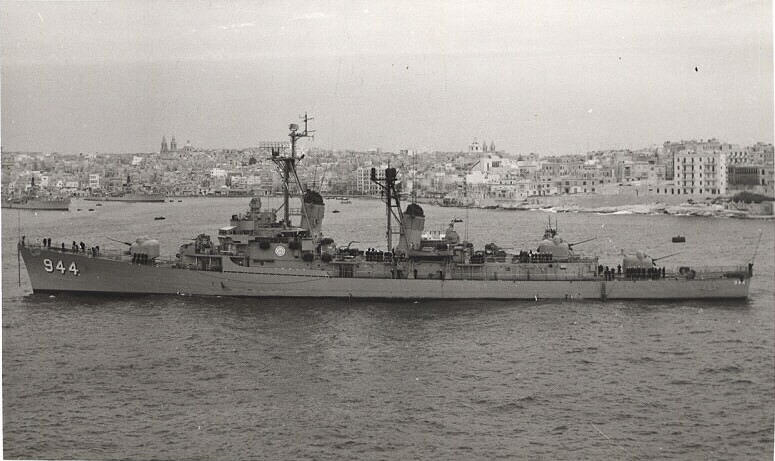
Mullinnix arrives in Sliema Creek, Valletta Harbor, Malta on 10 April 1961
1961 Mullinnix Deck Logs
January 1961 (PDF)
February 1961 (PDF)
March 1961 (PDF)
April 1961 (PDF)
May 1961 (PDF)
June 1961 (PDF)
July 1961 (PDF)
August 1961 (PDF)
September 1961 (PDF)
October 1961 (PDF)
November 1961 (PDF)
December 1961 (PDF)


Excerpt from "The Last Gun Ship - History of USS Mullinnix DD-944"
A Historical Novel By Frank A. Wood
[Note: Remember the definition of "Historical Novel" as McGee, Smythe, & Wiz are from my imagination!]
000-0400 Mid watch, Sunday, 1 January, 1961
As a brand new year comes once again,
The good ship Mullinnix rests in the U.S.A.
The time has come to pick up a pen
To write the log or New Year's Day.
The weather is clear, the temperature mild
And the ship is moored starboard side to.
Though in the past the weather's been mild,
Tonight we rest calmly with a weary crew.
Standard lines doubled are all that's required,
With a wire fore and aft to be sure
We'll stay safely put should the lines become tired.
Las year it was a Mediterranean Moor
Which held us in Naples, while in the Med.
We've since sailed far and wide
But in all our ports good relations led
To America's good will still undenied.
To France, to Spain, and to Italy too,
Our proud ship sailed with the Sixth Fleet,
Till February when our cruise was through,
And we headed for home to once again meet
Our loved ones and friends whom we hadn't seen
Since August of '59 when we left on our cruise.
To drydock we went, our bottom to clean,
Our sides to point and old sonar to lose.
The shipyard installed a new sonar for us,
And soon we sailed to Guantanamo.
Down there we were training at sea plus
Working at night. And so
We were glad to come home for three weeks
Before sailing again on the sixth of September,
After shining our brass and patching some leaks.
This time came a cruise we long will remember,
For 29 days were spent out at sea
And we crossed the Arctic Circle one day.
We visited Antwerp in Belgium where we
Stayed six days before we made our way
Down the Schelde River and to sea once more
To set our course toward home.
Again our families were waiting ashore
As we dressed the ship and polished the chrome.
And except for a short southern trip
We've been in local waters or here in port.
Tonight we're in Norfolk, as the southeast tip
Of Virginia, at the U.S. Naval Station, a sort
Of home away from home. Cold
Iron watches are set in all
Main propulsion spaces. Se we've rolled
Out the shore power cable lest the voltage fall,
And the steam lines for auxiliary steam,
With fresh water and phone lines also provided.
Units of the Atlantic Fleet are on the port beam,
And the starboard as well. Some foreign vessels have decided
To spend New Year's here, with a few
Yard and district craft nearby.
COMSECONDFLT is SOPA and a new
COMDESRON 32 has broken his pennant high
In this ship since last New Year's Eve.
And so as we rest quietly at our pier,
And the time comes for the watch to relieve,
It’s appropriate to will all a "Happy New Year".
Noel J. Fenton, LTJG, USNR
Examined: H.G. Dudley, LCDR
Approved: H.G. Dudley, LCDR, Acting Commanding
000-0400 Mid watch, Sunday, 1 January, 1961
Following the rhyming midwatch report, the first entry in the new year's log was courtesy of SK2 Panko. "R.C." blessed the ship with his arrival after being UA since New Year's Eve.
The ship left on 16 January for a brief Second Fleet LANTFLEX in the Virginia Capes Op-Area with her ever-present sailing partner USS Laffey DD-724 in accordance with COMCARDIV 4 OP-ORDER 1-61. Other ships present for these exercises included the heavy cruiser USS Newport News CA-148 (hi-lining GM2 Southerland to Newport News), USS Little Rock CLG-4, USS Forrestal CVA-59, USS Shangri La CVA-38, USS Northampton CLC-1, USS Canberra CAG-2, USS Mitscher DL-2, DESRON 8, DESRON 32 less USS Lowry DD-770 and USS Stormes DD-780, DESRON 4 less USS Gearing DD-710 and USS Vogelgesang DD-862, USS S.B. Roberts DD-823, USS Purvis DD-709, USS Triton SSRN-586,USS Sailfish SSR-572, and USS Pawcatuck AO-108.
Mullinnix, like any ship, was a microcosm of society - virtually every state, region, social class, and religion represented. This diversity made even these predictably boring LANTFLEX exercises seem almost tolerable. Exercises for what many wondered? Since the end of the Korean War, the world was at peace. Would the formidable firepower of the Sherman Class ever see action - real action? With a Med Cruise staring them in the face, 1961 appeared it was going to be a non-event. Wonder what '62 would bring? With exercises completed, the ship returned to Norfolk on the morning of 20 January.
Minus SRs Rothwell and Tegtmeier, and Fireman Morley, the ship got underway for anchorage FOXTROT, Newport News Channel, VA to unload hedgehogs on 1 February. It had to be 20 degrees outside and ten inside the steel-cold locker known as the MK68 Director, the wind-chill on the fantail toying with -15F. FTG3 Brian Smythe was half-frozen and numb sitting on the operator's station inside the Director. Circulation in his extremities had stopped eight smokes ago. A freezing mist, turning to snow, was fast making his buddy (and boss) McGhee, Fire Control 2nd Class, an asshole.
Old man winter, with salt in his hair from the high seas or with snow in his beard from the Russian steppes, either can be your enemy or your ally. It's very much up to you. Even with only one E-6, the ratio 'from petty officer to seaman' was unfair. Smythe felt like he'd been screwed standing watch in the Director during ammo detail. Unbeknownst to Smythe, the man that assigned him to the Director, Howard McGhee, was standing watch on the fantail.
McGhee took a sip of his coffee and swallowed most of the enamel from his teeth. "Fuck its cold", he thought. Glancing up, he watched as Signalman Glenshaw waved his flags, which he did in a way all his own, like a man very carefully drawing a diagram in the air. "Shit, how cold is it up there?" mused McGhee as the flags crackled in the snowy wind.
Snow began to fall heavily, coating Mullinnix like a soft white blanket. By 0902 visibility decreased to one mile. His foul-weather gear barely breaking even with the wind, he blew out great clouds of steamy breath. With the bitterly cold wind flapping the legs of his dungarees and pinching at his nostrils, McGhee stomped his booted feet to keep warm, thinking how he wished he was warm and toasty in the Director with Smythe.
Smythe was freezing his marrow. His self-indulging laughter was silvery in the cold air, his breath a frosty puff, sitting in the director, the metal seat cold as the grave.
Mucus from McGhee's nose had frozen in twin lines on his upper lip. His eyebrows were white with frost, as where his eyelashes. His cheeks were an unnatural red, and some drool was frozen to his chin. Finally, the ship came to a stop and McGhee could hear the anchor chain play out as the anchor crashed into the icy water. Once anchored, US Navy YTF-294 and YTF-328 came alongside port and off-loaded 188 service hedgehogs. By 1544 Mullinnix was back at Pier 20, moored port side to USS Sierra AD-18 - one last chance for crew members with families to make it home early to say goodbye to loved ones.
Thursday, 2 February - a day that single, divorced, and unhappy sailors live for. The same day that makes family men, and their families, gloomy. Can anyone say, "Med Cruise?" In accordance with CDS 32 OP-ORDER 1-61, as a unit of TG 25.2, Mullinnix pulled away from her berth at D&S piers headed for Rota, Spain, entering international waters at 1145. She would be gone 7 months as the flagship of Destroyer Squadron Thirty Two. Seaman Recruit Jack Rothwell would have to catch up with his ship at a later date, having been AWOL since 4 January.
These operations by the U.S. Sixth Fleet were such that peaceful and progressive relations were furthered with countries bordering the sea. European and Middle Eastern areas were stabilized by the sea based defensive forces, and the crew was ready to assist these neighbor nations in distress or too retaliated in defense of the United States.
Shore visits as well as underway periods for Mullinnix were utilized in support of these objectives. Diverse visits by the ship to major ports in France, Italy, Spain, Greece and Turkey assisted the President's "People to People" Program, as well as providing time for relaxation in preparation for the extensive at-sea periods.
While underway, Mullinnix participated in all phases of air defense, anti-submarine, gunnery, amphibious and replenishment operations, as well as innumerable drills and competitive exercises in communications, engineering and damage control. Repeated participation in those activities led to increased operational readiness and better individual performances by the ship and her crew. While deployed to the Sixth Fleet, Mullinnix won excellence awards from Commander Destroyer Force, U.S. Atlantic Fleet for outstanding performance in communications, operations, gunnery, and anti-submarine warfare.
By the next day, Task Group 25.2 was completed and included Mullinnix, USS Shenandoah AD-26, USS Suribachi AE-21, and DESRON 32 less USS Lowry DD-770 and USS Stormes DD-780.
The Atlantic in February just might be the ugliest sailor-unfriendly sea in the world. Howling wind, driving rain and sleet, mountainous waves of icy salt water coined the phrase, "pity the poor sailor on a night like this!"
McGhee and Smythe were grabbing a quick smoke on the 02 level, just forward of and above, the aft 3-in gun mount. It was a gray, raw morning with low clouds beginning to spit frozen rain. Two long banks of dark clouds with serrated edges straddled the horizon towards the sea. The sea was a heavy chop and the water was gray-green. Glancing down at the twin barrels of MT32, Smythe commented, "Fuck, there's icicles hanging off the barrels." With Mullinnix running more or less with the wind, McGhee pointed to the dimpled surfaces of snow that were starting to form on the decks. A snow storm at sea - you didn't see that every day. Within two drags of their smokes, it started snowing so hard the pair couldn't see MT53 from where they stood. Smythe squinted against the stinging cold and took in the vague halos of the running lights.
Taking a final drag and flicking his butt overboard, McGhee said, "Let's get the fuck inside. It's time to hit the maintenance schedule on the radar. Chief wants it completed before we see Spain."
They walked to the starboard hatch, opening it to a gust of warm air so heavy with moisture it seemed to have come from a humidifier.
_______________
Task Group 25.2 was joined by USS Salamonie AO-26 on Tuesday, 7 February. As is typical for a Med Cruise the crews’ days were filled with GQ drills, refueling, highline transfers, star shell firing exercises, and, regardless of department, the always-present preventive maintenance duties.
On 10 February, USS D. H. Fox DD-779 and USS Strong DD-758 detached from the group and proceeded independently to Rota. Mullinnix, USS Laffey DD-724, and USS Owens DD-776 stayed in formation, proceeding east. At 1705, Owens dropped out of formation due to an engineering casualty. Even as early as 1961, many of the WWII cans were starting to show their age despite significant upgrades to many of their systems. Eventually, even steel gets old.
At 1221 on 11 February, the ship proceeded to Rota, Spain for a brief refueling stop, mooring starboard side to a fuel pier. At 1935, the ship was once again underway for Pollensa Bay, Mallorca, Balearic Islands, Spain. Shortly after the midwatch on the 12th, the ship passed through the highly congested Straits of Gibraltar, joining an Attack Carrier Striking Group which lay at anchor in Pollensa Bay at the northwest corner of Mallorca.
That morning, the fog lookouts were stationed at 1042. The bank rolled in like melted marshmallows on a never ending black-jack branch, appearing like a horizontal strip made by an artist’s #3 brush. Mullinnix crept through the fog as the visibility was practically zero. Occasionally the lookouts could hear a foghorn from one of the other ships. While still immersed in the fog, the ship stationed the ASW attack team at 1144 to pursue a detected sonar contact bearing 037, distance 4500 yards. She broke off the search about one hour later as the contacted was evaluated to be 'non-submarine'.
On the morning of 13 February at 0758 she was anchored in Pollensa Bay in eight fathoms of water with a seaweed bottom. Her sister ship USS Davis DD-937 was received alongside to starboard a short time later. Mullinnix took on 15 rounds 5"/54 BL and P projectiles and 20 rounds VT non-frag from Davis. By 1614 she was underway once again to refuel from USS Truckee AO-147 then to rendezvous with USS Springfield CLG-7. Later that day, in conjunction with USS Saratoga CVA-60, the ship participated in ECM exercises.
At 0435 on 15 February, the ship was ordered to turn off all navigational lights. While darkened, she corrected course to 180 degrees by sinuous course clock, cam 1 and commenced turn count masking while Springfield and Shenandoah stood by.
At 0823, the crew was treated to a rare eclipse of the sun. As the sun ebbed behind the moon, the resultant shadow raced towards the Mullinnix like a blanket. In moments, the sun was three-quarters gone and the sea was sucking up the remaining light. The ship was in near darkness. The surface of the water was the color of tarnished bronze. The glow of the dying sunset filtered dimly onto the decks.
By early Thursday, 16 February, Mullinnix was steaming with Task Unit 60.1.9 that was composed of Springfield, Saratoga, USS Des Moines CA-134, USS O’Hara DDR-889, USS Stickell DDR-888, USS Cecil DDR-835, USS Steinaker DDR-863, USS Corry DDR-817, USS Wood DDR-715, and USS Leary DDR-879. At 0410, Mullinnix and O'Hara were detached from the group to conduct an ASW sweep.
Midwatch until pre-dawn, with the aroma of strong coffee, the lifeblood of the Navy, permeated everywhere. There's nothing like the feeling on a ship at sea at night - the masthead lights, the red and green navigation lights and stern light, the pulsating phosphorescence of radar repeaters - they cut through the dusk and join with the mirror of stars overhead. The drifting off to sleep (assuming you're not on watch) lulled by the myriad noises large and small that tell you that your ship is alive and well, and that your shipmates on watch will keep you safe.
When finished with the exercises a few hours later, she was anchored back in Pollensa Bay by 0803. She spent the night at anchor with various ships of the Sixth Fleet including USS Mississinewa AO-144, USS Dewey DLG-14, and USS Forrestal CVA-59, steaming once again at 1414 the following day.
On a ship, problems are never fixed. Ships are like a marriage - you are never done making it better. While on exercises on 18 February, Mullinnix experienced a low water casualty in 2B boiler. She had to reduce speed to 20 knots with the fires were secured under the boiler. The engineers quickly cross-connected the main engineering plant while the BTs relit the fires under 2B. Once the boiler was brought back on line, the ship returned her speed to 27 knots. That evening she supported the Forrestal while the carrier performed flight operations.
Chaos theory attempts to explain the fact that complex and unpredictable results can and will occur in systems that are sensitive to their initial conditions. A common example of this is known as the Butterfly Effect. It states that, in theory, the flutter of a butterfly's wings in China could, in fact, actually affect weather patterns in New York City, thousands of miles away. In other words, it is possible that a very small occurrence can produce unpredictable and sometimes drastic results by triggering a series of increasingly significant events. On Monday, 20 February, Mullinnix and Fox had just taken up their plane guard stations astern of Forrestal, when at 1713 one of Forrestal's fighter aircraft crashed into the sea off the port bow and sank. Was a butterfly responsible? Or was it insane to imagine that a single flap of a single seagull's wings would be enough to change the course of all future weather systems on the earth, and therefore Naval in-flight technical problems? Inevitable? Fate? Terms used by the Navy when carrying out their mission. The pilot, thankfully, was recovered by helicopter six minutes later.
In the early dawn light of 21 February, Mullinnix took on 64,035 gallons NSFO (Navy Special Fuel Oil) from USS Severn AO-61. Several hours later, a second special sea detail with USS Severn delivered mail to the Mux crew. Later, as the sun dipped below the horizon, USS Forrestal commenced flight operations with Mullinnix standing plane guard detail.
Shortly after midnight the ship passed through the Straits of Bonifacio in route to rendezvous with units of Task Force 60 in accordance with COMCARDIV 6 OP-ORDER 51-61, followed closely by USS M.C. Fox DDR-829 and USS Forrestal. At 0744 she anchored in Golfo degli Aranci, Sardinia with the following ships:
* USS Springfield CLG-7
* USS Forrestal CVA-59
* USS Shangri La CVA-38
* USS Little Rock CLG-4
* USS Mississenewa AO-144
* USS Neosho AO-143
* USS Severn AO-61
* USS Shasta AE-6
* USS Suribachi AE-21
* USS Bigelow DD-942
* USS Mitscher DL-2
* USS Sumner DD-692
* USS D. H. Fox DD-799
* USS Corporal SS-346
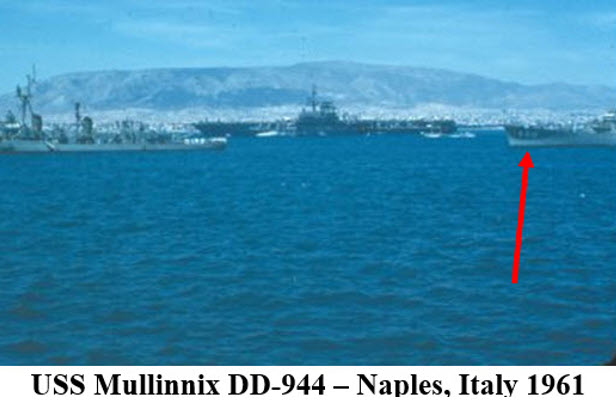
Upon receiving 52,462 gallons NSFO from USS Severn on 23 February, Mullinnix steamed towards Naples, Italy arriving at 0920 - being Mediterranean moored at berth 72, Molo Angioino, Naples.
GO TO Liberty Call Naples Italy 1961
Much has been said about the hurricane bow of the Forrest Sherman Class. Many Tin Can Sailors stationed on older ships noticed as well. Sonny Walker, Laffey Association (USS Laffey DD-724), recalling the 1961 Med Cruise, stated, "We were in DESRON 32 and the Mullinnix was our flag ship. We envied that high bow when the weather got rough."
USS Laffey is significant because of her action on 16 April 1945, when she fought one of the most famous destroyer-kamikaze duels of the Pacific War. She was attacked by 22 Japanese kamikazes and bombers in the span of ninety minutes. She managed to shoot down 11 of the attacking planes while being hit by five kamikazes and two bombs killing 32 and wounding 71 of her crew. For this action she was awarded the Presidential Unit Citation.
With the aid of civilian pilot Captain Cocorulio, Mullinnix got underway from Naples at 0715 on Friday, 3 March. Before the end of the midwatch on 4 March, Mullinnix was operating in the Tyrrhenian Sea. At 0915 she transferred two German officers from USS Little Rock CLG-4.
"Here come the Krauts", Announced FTG3 Smythe as twin-trails of smoke leaked from his nostrils.
"Yep, just think. Less than 16 years ago, we were kick'n their ass all the way back to Berlin", Figured McGhee.
GQ was sounded at 1300, setting material condition ZEBRA. At 1339, the ship conducted ABC defense drills.
"I don’t know about you, but these drills scare the shit out of me", Said Smythe.
"Why's that?" Asked McGhee.
"Spooky. They're just damn spooky. You know what ABC stands for, right?"
"Atomic Bacterial Chemical attack. Why?" Answered McGhee.
"Tell me somethin'. We're on a ship with 3 5" guns, 2 double-barrel 3", and a couple torpedo tubes."
"So?"
How in the fuck are we supposed to survive a fuck'ing A-bomb? Or a fuck'ing bug attack or some fuck'in-ass chemical, huh? Tell me that."
"We don't."
"What?"
"We don't. We take one for the bigger ships - like the carrier over there", Said McGhee.
"Fuck me. Fuck me. Fuck me. I need a smoke", Smythe answered.
"Smoking lamp is out."
"Like a said, spooky. Here I am practicing how to turn green inside, or out, or both, and the Navy tells me I can't smoke. Fuck me..."
Operating of the coast of Sardinia, the crew stationed the helicopter detail several times during 5 March, receiving them from USS Shangri-La CVA-38. On the morning of 6 March she anchored in Golfe de la Napoule, Cannes, France.
Cannes is one of the best-known cities on the French Riviera. The city was in the throes of preparing for the 13th Annual Cannes Film Festival being held from 4 to 20 May.
GO TO Liberty Call Cannes France 1961
Mullinnix left Riviera-good-times, new female friendships, and even a couple broken hearts, as she got underway at 0701 on 10 March, in route to Augusta Bay, Sicily as a unit of TU 60.21 in accordance with COMCARDIV 4 OP-ORDER 52-61. At least one shipmate was thanking God he was aboard ship.
Saturday, 11 March found Mullinnix proceeding to rendezvous with the replenishment group. First up was replenishment by helicopter from USS Altair AKS-32, receiving 6 net loads. This was followed by fuel transfer from USS Salamonie AO-26 and then an ammunition transfer drill with USS Shasta AE-6. At 1427 she took on provisions from USS Rigel AF-58 and finally a light line transfer with USS Moale DD-793.
While steaming in the Tyrrhenian Sea, LTJG D. M. Whitt returned aboard to resume his regular duties after completing his TAD at Key West, Florida. On 13 March the shipped anchored at 0736 in Golfo di Catonia Bay, Sicily in 15 fathoms of water. MMI K. Reid was transferred to USS Shangri-LA CVA-38 with appendicitis. Mullinnix was back underway by 2030 for fleet operations and in route to Istanbul, Turkey.
Operating in the Ionian Sea off the coast of Sicily, the ship had to suspend training to investigate an intermittent radar and ECM contact. The ASW attack team was stationed at 1343. As is common, the vast majority of these contacts never materialize into much. However, with the Russian in the same waters performing the same type training, you have to treat each one as real. No one ever knows, but this contact could have been Russian that managed to slip away at the last minute due to their training and drills. More than likely it was the USS Sea Cat SS-399 playing cat-a-mouse with her own destroyers. Mullinnix secured the ASW team and shut down the steam to the port shaft, a maneuver called "port shaft trailing". This changes the sonar-marking that is unique to every ship in the world.
With multiple daily sonar contacts, Mullinnix steamed into the Aegean Sea during the midwatch on Saturday, 18 March. After receiving fuel from USS Pawcatuck AO-108, Mullinnix spent the afternoon simulating attacks on USS Trutta SS-421.
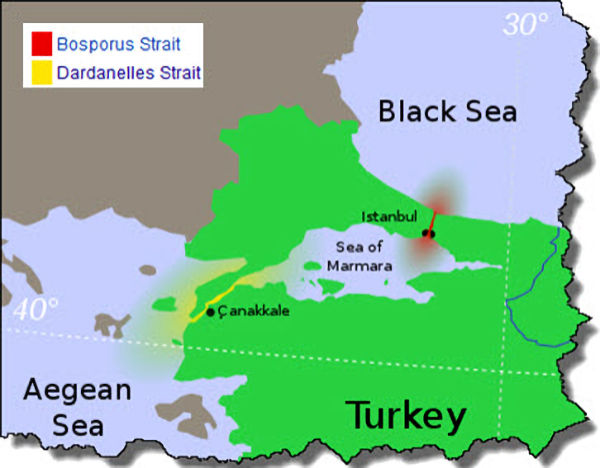
She proceeded north through the Dardanelles, the Sea of Marmara, where she and the USS Hawkins DDR-873 broke away from the Carrier Striking Group, then through the Bosporus and up into the Black Sea.
She began transit of the Dardanelles at 1408 on 23 March. Uyasbaba Burnu light was bearing 358, distance 1.7 miles. By the midwatch on 24 March, she had entered the Sea of Marmara. Together with the Bosphorus Straits, the Dardanelles form the Turkish Straits.
At 0010 she suddenly changed her course to avoid an unidentified radar. A Russian cruiser - began 'escorting' Mullinnix literally side-by-side. If she slowed, the Russia ship slowed, if Mullinnix sped up, so did the Russians. Late in the afternoon, the Mux skipper decided to perform a little 'research'. The CO called the engine room and ordered them, "stand by to answer all bells!" Slowly the skipper started increasing speed until the ship was near flank speed, with the Russian still welded by her side. Then the captain ordered, "all back and hard right rudder!" Mullinnix started shuddering and shaking but came to a screeching halt as she turned around a full 180 degrees and steamed at flank speed the other way. The larger, heavier Russian ship was caught off guard, flying past Mullinnix. It took the Russians a 5-mile wide turn and almost 45 minutes to regain their station 'shadowing' the US destroyer side-by-side once again.
This sort of 'exercise' does wonders for ship moral, hence the Mullinnix CO performed the maneuver several more times.
At 0408 the Yesilkos Aero beacon was sighted and at 0425 the Yesilkey Light was sighted. By 0650, the Captain was maneuvering the ship into Istanbul Harbor. With the aid of a local navigator on the bridge, she bypassed Istanbul and completed transit of the Bosphorus Strait, entering the Black Sea at 0918 on course 034, speed 15 knots. The Bosphorus Strait is a narrow, natural strait and an internationally significant waterway located in northwestern Turkey. It forms part of the continental boundary between Europe and Asia. The world's narrowest strait used for international navigation, the Bosphorus connects the Black Sea with the Sea of Marmar.
Within 2 minutes, USS Hawkins DD-873 and Mullinnix were performed a light line transfer. Hawkins and Mullinnix anchored in Eregli Harbor, Eregli, Turkey at 0801 on 25 March. This represented only the third visit that the Sixth Fleet had ever paid to that city.
Eregli was a Greek city in ancient times known as Heraclea Pontica after the Greek mythical hero Heracles. The Turkish name Karadeniz Ereğli means "Black Sea Ereğli" (kara="black", deniz="sea").
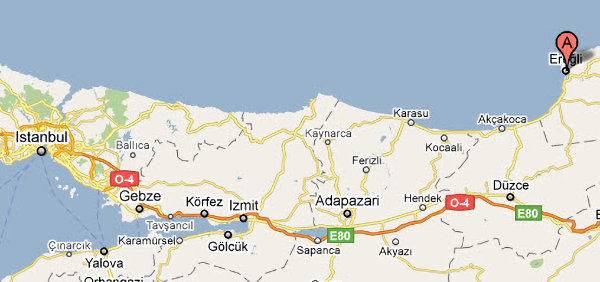
It was founded by a Megarian colony, which soon subjugated the native Mariandynians and extended its power over a considerable territory. The prosperity of the city, rudely shaken by the Galatians and the Bithynians, was utterly destroyed in the Mithridatic Wars. It was the birthplace of Heraclides Ponticus. According to Greek mythology, the cave guarded by the three-headed dog Cerberus is located near the town. For his final quest, Heracles is tasked with entering the cave and capturing Cerberus.
It has a large natural harbor, located in the lee of Baba Burnu and therefore one of the few geographically attractive places for a harbor on the western Black Sea coast of Turkey. Because of its Black Sea beach, Ereğli is a popular tourist destination locally. In addition to fishing, Ereğli is also well known for its delicious Ottoman strawberry.
Social change and political radicalization in Turkey in the 1960s was a period of increasing violence and tensions in Turkish society which led to almost a civil war in the 1970s. The Muxmen would have to be extra careful in this port of call.
GO TO Liberty Call Eregli, Turkey 1961
The following morning, with the anchor aweigh at 0925 and the Captain on the conn, the ship headed to Samsun, Turkey, dropping anchor in this port at 0743 on 27 March.
At 0830, The Chief of Security, Samsun, Turkey, representing the Governor, made an official call on Captain John H. Carmichael, USN, COMDESRON 32. As customary, Mullinnix rendered honors. At 0921, COMDESRON 32 left the ship to call officially on the Governor, Samsun, Turkey and to lay a wreath at the monument of Ataturk. Later in the day, the Governor of Samsun returned the official call of COMDESRON 32.
Samsun, a relatively small village, is the provincial capital of Samsun Province and a major Black Sea port. Samsun is a long city that extends along the coast between two river deltas which jut into the Black Sea. It is located at the end of an ancient route from Cappadocia: the Amisos of antiquity lay on the headland northwest of the modern city. To Samsun's west, lies the Kızılırmak ("Red River", the Halys of antiquity), one of the longest rivers in Anatolia and its fertile delta. To the east, lie the Yeşilırmak ("Green River", the Iris of antiquity) and its delta.
GO TO Liberty Call Samson, Turkey 1961
The ship was underway the following morning for Istanbul, Turkey. Darkened ship was ordered with the exception of navigational lights, typical operations in this part of the world. Their Russian escort picked them up just outside the harbor and accompanied the ship back to the Straits. Before entering Istanbul harbor, the ship refueled from USS Salamonie AO-26. She anchored in Istanbul Harbor at 1121.
GO TO Liberty Call Istanbul, Turkey 1961
Mullinnix left this fixture of the orient on Easter morning, 2 April, in route to Athens, Greece. Steaming independently, she anchored in Athens at 0808 on 3 April. A significant portion of the fleet was present including USS Forrestal CVA-59, USS Springfield CLG-7, USS Mississenewa AO-144, USS Suribachi AE-21, sister ship USS Manley DD-940, USS Mitscher DL-2, USS Bailey DDR-713, USS Goodrich DDR-831, and USS Ellison DD-894. At 1330, she loaded one MK32 Mod 2 torpedo, forty MK 12 hedgehogs, and forty MK 33 Mod 0 cartridges. By 1617 the ship was underway to Rhodes, Greece, steaming independently.
While conducting drone firing exercises on 7 April, the ship experienced a hang fire (a round stuck in the barrel) in MT 51. Hang-fire occurs when there is a delay beyond the normal ignition time after the initiating action is taken (e.g. the gun fires 15 seconds after the firing key is closed). The mount had been firing for only 2 minutes, therefore it was considered a “cold gun" condition, where the gun barrel and chamber wall temperature have not been raised by prolonged firing to a point where "cook-off" can occur.
Extensive testing of the 5"/54 under continuous sustained firing conditions had shown cook off temperature is achieved in approximately 3 minutes. Cook-off occurs when components of the gun reach a temperature high enough (e.g. "hot gun") to cause some form of explosive reaction in the projectile. As long as the breech is closed, cook-off will cause the round to be fired in a near normal manner. However, with the breechblock open, cook-off usually results in personnel injuries/fatalities and major equipment damage.
Regulations require that the gun mount remain idle for two hours in a safe firing bearing to preclude danger to other craft and friendly forces in the event of a cook-off. With fully charged fire hoses at the ready, MT 51 was fired to starboard at 1253, with the casualty restored.
At 1241 on 8 April LCDR J. R. Pouliot reported aboard for duty in accordance with BUPERS Mag 011703. In a matter of a few days he would become the Mullinnix' new XO.
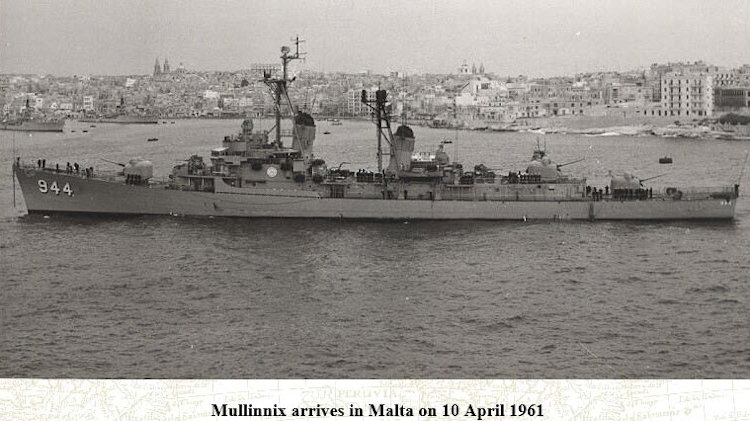
At 0823 on 10 April she moored in Sliema Creek, Valletta Harbor, Malta, in Berth 12. LTJG Carven III left the ship with his shore patrol party to report to the Royal Navy Pickett House, Kingsway, Valletta.
In the afternoon of 12 April, the HMS Camperidown D-32 entered the harbor and moored in berth 7 followed by HMS M-1180 and HMS Solebay D-70. The big question the crew was asking: Will the Brits and Americans get along on liberty?
A bowling tournament and exchange dinner with HMS Solebay highlighted the visit. Solebay would be decommissioned the following year in April 1962.
GO TO Liberty Call Malta 1961
At 0650 on 13 April, LCDR Harrison G. Dudley was detached from Mullinnix to proceed and report to USS William M. Wood, for duty as her Commanding Officer. A little over one hour later, Mullinnix cleared the harbor and was back to work with the fleet.
In the spirit of international corporation, the ship high-lined LCDR Franeo Di Giamberardino, Italian Navy to USS Ellison on the afternoon of 15 April. Mullinnix participated in operation Medflex Invicte, Part I, conducted in the Strait of Sicily. This exercise was terminated on 16 April with the deactivation of Task Group 239.2 and the reactivation of Task Unit 60.2.1.
At times, the number of dignitaries aboard ship can be a bit much. That was the case on 17 April when the following ASW observers reported aboard as observers:
* Captain Gonsale Diaz Garcia, Spanish Navy
* LCDR Antonie Tartesa Navarre, Spanish Navy
* LCDR Ricardo Ruiz de Gopequi, Spanish Navy
* LT Juan Fernando Ruiz Montero, Spanish Navy
* CDR William McGovern, USN
* LCDR John J. Uzdevenes, USN
With orders coming from the US Embassy in Madrid, there was only one course of action: suck it up Navy! Once Pilot Jose De Aquiree left the ship, Mullinnix headed for Barcelona, Spain.
_______________
That same day, less than three months after John F. Kennedy assumed the presidency, the Bay of Pigs invasion was launched, lasting only 3 days. The invasion was an unsuccessful attempt by a CIA-trained force of Cuban exiles to invade southern Cuba with support from US government armed forces, to overthrow the Cuban government of Fidel Castro.
During the night of 14 and 15 April, a diversionary landing was planned near Baracoa, Oriente Province, by about 160 Cuban exiles commanded by Higinio 'Nino' Diaz. Several US Navy destroyers were stationed offshore near Guantanamo Bay to give the appearance of an impending invasion fleet.
Late on 16 April, the CIA / Brigade 2506 invasion fleet converged on "Rendezvous Point Zulu", about 40 miles south of Cuba, having sailed from Puerto Cabezas in Nicaragua where they had been loaded with troops and other materiel. The US Navy operation, code-named Bumpy Road, included five 2,400-ton freighter ships chartered by the CIA outfitted with anti-aircraft guns. The freighters were planned to transport about 1,400 troops and armaments near to the invasion beaches. The freighters sailed under Liberian ensigns. The ships were escorted (outside visual range) to Point Zulu by US Navy destroyers USS Bache, USS Beale, USS Conway, USS Cony, USS Eaton, USS Murray, USS Waller. A task force had already assembled off the Cayman Islands, including aircraft carrier USS Essex, with task force commander John A. Clark (Admiral) onboard, helicopter assault carrier USS Boxer, destroyers USS Hank, USS John W. Weeks, USS Purdy, USS Wren, and submarines USS Cobbler and USS Threadfin. Command and control ship USS Northampton and carrier USS Shangri-La were also reportedly active in the Caribbean at the time. USS San Marcos was a Landing Ship Dock that carried three LCUs (Landing Craft Utility) and four LCVPs (Landing Craft, Vehicles, Personnel).
By 19 April, without direct air support, and short of ammunition, Brigade 2506 ground forces retreated to the beaches in the face of considerable onslaught from Cuban government artillery, tanks and infantry. Destroyers USS Eaton (code-named Santiago) and USS Murray (code-named Tampico) moved into Cochinos Bay to evacuate retreating Brigade soldiers from beaches, before firing from Cuban army tanks caused the order to withdrawal.
_______________
Mullinnix moored port side to Muelle de Bosh Alsine Pier at 0910 on 19 April.
Naval Station Rota, also known as NAVSTA Rota, is a Spanish naval base commanded by a Spanish Rear Admiral and fully funded by the United States of America. Located in Rota in the Province of Cadiz, near the town of El Puerto de Santa Maria, NAVSTA Rota is the largest American military community in Spain.
NAVSTA Rota has been in use since 1953 when Spanish dictator Francisco Franco strengthened relations with the United States in order to improve local economies. The installation covers more than 6,000 acres on the northern shore of Cadiz, an area recognized for its strategic, maritime importance over the centuries.
GO TO Liberty Call Rota, Spain 1961
With the majority of the crew well rested (some had trouble walking), she steamed out of the harbor on 26 April, heading back to Sardinia. In the wee hours of the midwatch an unidentified surface contact turned out to be USS Grant County LST-1174, a De Soto County-class tank landing ship commissioned in late 1957 and named after counties in fifteen states. She will be the only U.S. Naval vessel to bear the name Grant County. USS Fremont APA-44 and USS Waldo County LST-1163 joined the formation a couple hours later. That afternoon she anchored in Sardinia near:
* USS Pocono AGC-16
* USS Seal Owl SS-405
* USS Exploit MSO-440
* USS Observer MSO-461
* USS Affray MSO-511
* USS Alacrity MSO-520
* USS McCard DD-822
At 1500, USS McCard reported a fire aboard but required no assistance. Mullinnix got underway at 1658. By 28 April, Task Force 61 had grown to almost 30 ships. The group practiced ASW exercise for most of the morning. Mullinnix anchored back in Porto Scudo Bay at 1155 only to leave again at 1442 in order to patrol gunfire support area, returning to Sardinia at 1715. She left and returned twice to Sardinia on 29 April. The crew begin to wonder if they were practicing the Navy's version of ping-pong. After several days of extensive fleet exercises Mullinnix anchored at Taormina Harbor, Taormina, Sicily at 0802 on 3 May.
GO TO Liberty Call Taormina, Sicily 1961
She left early on 6 May for operations in the Ionian Sea and exercises with USS Hawkins DDR-873 and USS Trutta SS-421. On 7 May, she supported the USS Roosevelt CVA-42 with plane guard protection.
The Libyan tanker Aquuag passed astern at about one mile while Mullinnix and four other destroyers (Goodrich, Rush, Hawkins, and Turner) were in a five-ship concentric screen formation at 0330 on 8 May. The tanker entered the screen, sounded two short blasts and altered her course to port. Coincidence or a test for the American Navy?
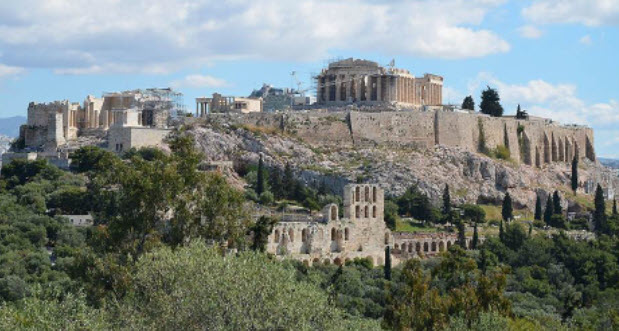
The afternoon of 10 May, found the ship performing AA gunnery firing exercises, expending 43 round of 3 inch VT non frag and 32 rounds of 5 inch VT frag. And again on 13 May, she expended 20 rounds of 3”/50 armor piercing, 53 rounds of 5”/54 anti-aircraft common, 16 rounds 5”/54 AA common, 8 rounds 5"/54 illuminating and 24 rounds 5"/54 SPDN projectiles with no casualties. On the afternoon of 15 May, Mullinnix anchored in Falirou Bay, Athens, Greece.
GO TO Liberty Call Athens, Greece 1961
While anchored, the ship took on 100 rounds of SPDN 5"/54 caliber powder, 32 rounds of 5"/54 VT projectiles, 50 rounds 5"/54 BL and P projectiles, and 105 rounds of 5"/54 AAC projectiles. The ship steamed out of Athens on 22 May.
At 1403 on 22 May, Mullinnix sighted jet an aircraft launched from USS Roosevelt's port catapult crash about 100 yards ahead of carrier. The captain was on the conn and he observed a partly opened parachute about 20-30 feet above the water and about 100 yards astern of Roosevelt. A Navy helicopter raced to the scene and hovered over the parachute. Mullinnix proceeded to the position of the helicopter as she dropped the helo crew member into the water in an attempt to assist the downed pilot. All engines stopped was ordered at 1413 while the helicopter crew recovered the pilot and left the area to resume rescue helo station on the carrier.
Mullinnix was directed to undertake rescue of downed pilot. She lowered the motor whale boat into the search area of crash. The pilot's parachute was no longer visible. She proceeded to search the crash area steering various courses and speeds. The Mux' whale boat recovered small pieces of aircraft debris, but there was no evidence of the pilot. Roosevelt ordered carrier propeller aircraft to assist in the search. At 1530, USS Little Rock CLG-4 and USS Laffey DD-724 joined in the search. At 1550, Mullinnix recovered her motor whale boat. Unfortunately, the pilot was never recovered.
Mullinnix continued to participate in flight ops with Roosevelt until 24 May. That afternoon at 1512, following a successful full power run at 32 knots, she intercepted a message on fleet broadcast that said a passenger aboard SS Atlantic, 100 miles east of Malta, required assistance due to a possible perforated ulcer. Roosevelt dispatched a helicopter and Mullinnix steamed toward the stricken ship, spotting her at 1530. Ready to lower the whaleboat if required, the Navy decided to transfer the patient via helicopter.
COMDESLANT, RADM Weakley joined Mullinnix on 28 May via a helicopter ride from Roosevelt. The ship anchored in Gulfo De La Napoule, Cannes, France with Roosevelt, Little Rock, USS Salamonie AO-26, USS Shasta AE-6, USS Hawkins DDR-873, USS Johnson DD-821, and USS Rush DDR-714.
GO TO Liberty Call Cannes, France 1961
She left Cannes on 9 June to continue plan guard duty for Roosevelt. Between plane guard duty and gunnery exercise, the crew kept busy through 14 June, when Mullinnix anchored in Golfo di Palmas, Sardinia. With two passengers from USS Johnston DD-821 (LTJG James S. Person Jr and BT2 James B Oliver, left steamed out of Sardinia, in route to Palermo, Sicily. The ship moored starboard side to Pier Piave, Palermo shortly after 0800 on 16 June.
GO TO Liberty Call Palermo, Sicily 1961
BT2 "H.G." Roundtree and the rest of the Shore Patrol detail returned to the ship at 0120 on the same morning of 17 June. She left the harbor at 0650 and by 0730 had exercised the crew at general quarters. Following the setting of the ASW attack team and securing same, Mullinnix took up plane guard detail for USS Roosevelt CVA-42. USS Rush DDR-714 relieved Mullinnix at 1555.
At 0043 the ship identified radar contact bearing 315 at 17 miles as USS Springfield CLG-7. At 0600 on 18 June, she was released by OTC to proceed to station in special formation fro AF South Tenth Anniversary Naval Parade.
Midwatch on 19 June found Mullinnix operating of the coast of Italy in the Tyrrhenian Sea. The following day she positioned herself approximately 3000 yards northwest of Filfla Rock and at 1147 commenced shore bombardment exercise, firing to starboard. On 22 June, the ship headed to Augusta Bay, Sicily arriving at 0832 and anchoring in anchorage Z-12 in 10 fathoms of water with 45 fathoms of chain to the port anchor. By 1412 she was underway once again as a unit of Task Unit 60.2.9 in compliance with COMCARDIV 4 OP-ORDER 55-61.
Shore bombardment was again the order of the day on 23 June. She conducted direct fire, in direct fire, and D-day fire gunnery exercises. On the afternoon of 24 June the Navy added a little wrinkle to the exercises. The crew was called to general quarters at 1343 - SOP (standard operating procedure). But at 1408, the ship commenced surprise AA gunnery exercises. This required the mounts to first fire to port for 3 minutes. Eight minutes later, the mounts were ordered to fire to starboard for 2 minutes. Cease fire for 6 minutes. Commence fire - cease fire - commence firing to port - cease fire. By 1717 the ship had expended 115 rounds of 3"/50 cal VT non-frag, 12 rounds 5"/54 cal VT frag, and 82 rounds 5"/54 cal VT non-frag with no casualties.
During exercises in the early morning of 25 June, the ship's visibility decreased to 75 years due to heavy fog. As the sun broke over the horizon, the fog-defused light looked like a distant fire storm. The fog appeared like a horizontal strip made by an artist's #3 brush. The ship's lights blinked in the fogbank like a storm cloud filled with lightening. She commenced sounding fog signals and stationed lookouts in the eyes of the ship. USS Laffey DD-724 and Mullinnix were detached from the fleet and ordered to proceed to Gaeta, Italy at 0400 on 26 June. She moored to buoy C-2 Gaeta, Italy with 8 fathoms of chain on deck to the starboard anchor chain. Shore Patrol Officer left the ship for temporary duty at 1130.
GO TO Liberty Call Gaeta, Italy 1961
Without Seaman O'Rourke and ETR3 Collier, and Wiz, Mullinnix was underway at 0754 for Naples, Italy on 1 July, mooring starboard side of USS Laffey at Angioino Pier at 1716. Surprising their mates, both Collier and O'Rourke returned to Mullinnix at 1750, having hitch a ride on the Laffey. None would admit if it was intentional or not, but many suspected they’d simply staggered onto the wrong ship after a hard night in Gaeta.
GO TO Liberty Call Naples, Italy (Return Trip) 1961
La Spezia is a port city in Liguria, Italy. Its 1800s-maritime arsenal and the Technical Naval Museum, with ship models and navigational instruments, attest to the city's seafaring heritage. The hilltop St. George's Castle houses an archaeological museum with artifacts from prehistory to the Middle Ages. The nearby Amedeo Lia Museum exhibits paintings, bronze sculptures and illuminated miniatures in a former convent.
At 2008 on 22 July, Mullinnix slipped away from the pier, in route to Aranci Bay, Sardinia, anchoring at ZULU 17 in Aranci Bay at 0618 the following morning. She left her berth at 1830 later the same day.
Mullinnix participated in NATO exercise "South Wind" air and anti-submarine operations on 27 July. She focused on anti-submarine attacks with USS R. A. Owens DDE-827.
After day after day of long, never ending exercises, refueling, and what the crew felt was a general 'screwing around' in the Med, the ship was ordered to head to St. Jean, France on 29 July, anchoring at 0801.
GO TO Liberty Call St. Jean, France 1961
She left St. Jean on 7 August back to fleet operations. Where to? More firing exercises were conducted on 8 August, expending 52 rounds of 5". Mullinnix engaged the replenishment group on 9 August, taking on fuel from USS Mississenewa AO-144 followed by ammunition transfer from USS Shasta AE-6. She commenced vertical replenishment from USS Altair AFS-32 at 1025 and by 1301 Mullinnix was transferring ammunition to USS Mississenewa.
She spent the next several days steaming with USS Franklin D. Roosevelt CVA-42. The Roosevelt was the second of three Midway class aircraft carriers. To her crew, she was known as the "Swanky Franky," "Foo-De-Roo," or "Rosie," with the last nickname probably the most popular. Roosevelt spent most of her active deployed career operating in the Mediterranean as part of the Sixth Fleet. The ship was decommissioned in 1977 and was scrapped shortly afterward.
At 1418 on 11 August, the ship lost the electrical load while shifting from 1 and 3 ship's service generators to 2 and 4. She re-shifted the load back to 1 and 3, but at 1428 an electrical fire broke out on the reefer decks. The ship immediately went to general quarters, setting material condition ZEBRA throughout the ship. The fire in the No. 2 reefer motor was quickly extinguished.
The ship arrived at Golfo Di Palmas, Sardinia at 1649 on 14 August. The following morning at 0830 US Newport News CA-148, USS Intrepid CVA-11, USS DuPont DD-941, USS Henley DD-762, USS Ault DD-698, USS Putnam DD-757, and USS Keith DD-775 stood into the anchorage and anchored. In accordance with BUPERS Message 101629Z, Captain I. C. Kidd, Jr. relieved Captain J. H. Carmichael, as COMDESRON 32 and COMDESDIV 321.
Headed home, finally...at 1418, Mullinnix pulled up anchor and headed home to Norfolk, Virginia.
_______________
Smythe and McGhee watched a glow of light on the port horizon. The slender crescent moon was not yet large enough to obscure the stars, but clear enough to draw one's spirit. Illuminated by the sparkling night sky, the ocean rolled in smooth silver waves. There is something mystical about steaming between the darkness of the ocean and the glow of the evening moonlight. It isn't just that you feel dwarfed by the planet in the quiet of the night, but more like you have found the edge of the world and could dive off if you wanted to.
"He was two tons of shit in a one-ton shit bag. Nobody liked him. He didn't care. All he was interested in was his standard '$10-for-$20' on payday," said Smythe.
"Who?" asked McGhee.
"Nickols!"
"Sam Nickols? Sewer Sam Nickols?"
"Yeah."
"Hell, that's like flushing your money done the shitter," said McGhee.
"He was a smarmy son-of-a-bitch, for sure," added Smythe.
The Mullinnix was surrounded by blue air and bluer sea. Slight swells with no white caps. A near perfect day for making good time at 25 knots.
McGhee lit his cigarette. Smythe watched the match - its strike, its small bloom of flame, its progress to the tip of the cigarette. It was rather excruciating. He coughed. "Can I bum one of those from you?" He'd quit tomorrow.
"You ever notice there isn't any flies at sea?" asked McGhee. "In the Gulf of Mexico, they dry shrimp on the abandoned oil platforms - no flies."
"McGhee, you are the potentate of useless information."
"Fuck you, Smythe."
_______________
The Mullinnix didn't make much noise while steaming. Of course, there was the watery sound of the sea being sliced in two by the bow. The two halves slipping past port and starboard like lubricated gelatin. In place of sound, there was a feeling, a constant low-frequency vibration. A sense really, that unseen mechanical motion was hard at work driving the ship relentlessly to her next destination.
At 1208 on 25 August, COMCRUDIV 4, RADM Williamson, and his Chief of Staff arrived on board by helicopter to pay an unofficial visit to COMDESRON 32.
Early on 28 August, Mullinnix proudly led USS J.C. Owens DD-776, USS Laffey DD-724, USS Strong DD-758, and USS D.H. Fox DD-779 into Chesapeake Bay. She moored port side to Berth 232 Pier 23, Destroyer and Submarine Piers, Norfolk Naval Base at 0808.
Stand down. Crews need that after a long voyage. Some moved their wives and families to Norfolk. Others took extended leave home to see love ones and sweet hearts. Yet others, were transferred or discharged - it was a tide that washed over all of them, leaving some on high ground and dragging others out to sea - some come, some go.
Mullinnix moored port side to the destroyer tender USS Shenandoah AD-26 Pier 21, Berth 212 on 1 September. Outboard were USS Laffey DD-724 and USS Basilone DD-824.
To be continued...
_________________
The Mullinnix (flagship of Destroyer Squadron 32) sailed on a Med cruise from 2 February 1961 and returned home on 28 August (208 days) having steamed 48,300 nautical miles and burning 3,202,000 gallons of fuel oil. Read the brief overview of the cruise penned by Captain William H. Shaw. This cruise included her first duty in the Eastern Mediterranean.
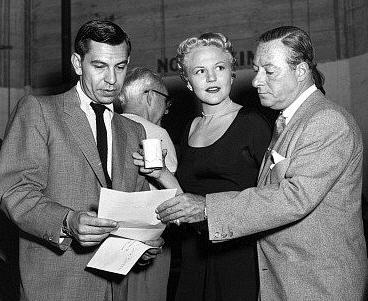
L to R: Jack Webb, Peggy Lee, George Jessel
Ports of Call
2 February ---------------------------- Depart Norfolk, VA
11 February --------------------------- Rota, Spain (refueling only)
13 February ------------------------ Pollensa Bay (ammo from USS Davis only)
16-17 February ------------------------ Pollensa Bay, Island of Mallorca
24 Feb - 2 March ---------------------- Naples, Italy
2-6 March ----------------------------- Cannes, France
25 March ------------------------------ Eregli, Turkey
27 March ------------------------------ Samsun, Turkey
30 March - 2 April -------------------- Istanbul, Turkey
3 April ------------------------------- Athens, Greece (briefly)
10-14 April --------------------------- Malta
17 April ------------------------------ Palma, Mallorca
19-25 April --------------------------- Barcelona, Spain
3-6 May ------------------------------- Taormina, Sicily
15-22 May ----------------------------- Athens, Greece
Early June ---------------------------- Cannes, France
5 June -------------------------------- George Jessel performed on the ship
22 June ------------------------------- Augusta Bay, Sicily (briefly)
26 June-1July ------------------------- Gaeta, Italy
1-5 July ------------------------------ Naples, Italy (Naples Invitational Softball Tournament)
3 July -------------------------------- COC (Commander Shaw relieved Commander Hill)
10-22 July ---------------------------- La Spezia, Italy (tender availability - USS Shenandoah AD-26)
29 July - 7 August -------------------- St Jean, France
15-16 August -------------------------- Golfo di Palmas, Sardinia (turnover ceremony to DuPont DD-941)
28 August ----------------------------- Norfolk, Virginia
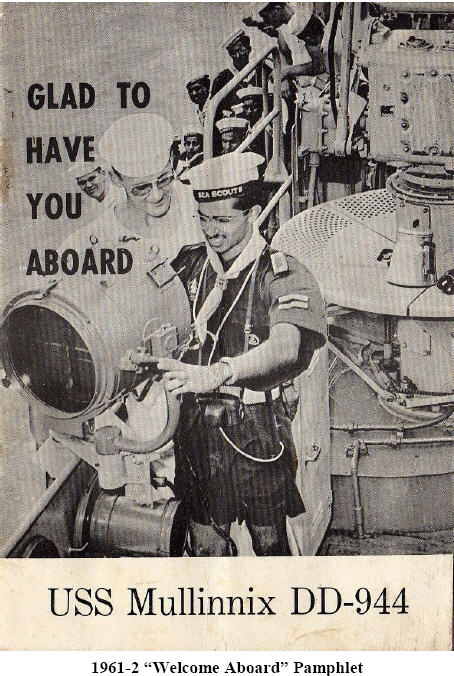
Click on the above image to open PDF file
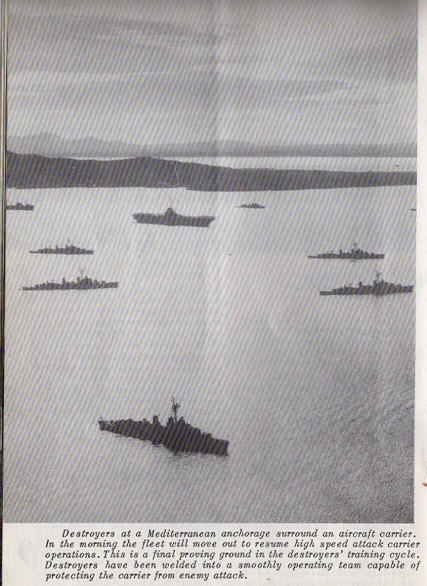
Order of the Black Realm
Be it known to all swabs, shell backs and pollywogs that (Name) is known in the waters of the BLACK SEA by virtue of his journey through the Bosphorus and into the BLACK REALM aboard the vessel USS MULLINNIX DD-944 (Date) during the journey of United States Warships into this province of NEPTUNUS REX since the SECOND GREAT WAR and is a member of the U. S. BLACK SEA FLEET.
By authority RULERS OF THE BLACK REALM
(Name), CDR, USN
COMMANDING
(Note: Above example is from USS JOHN W. WEEKS DD-701, 9 March to 14 March 1960)
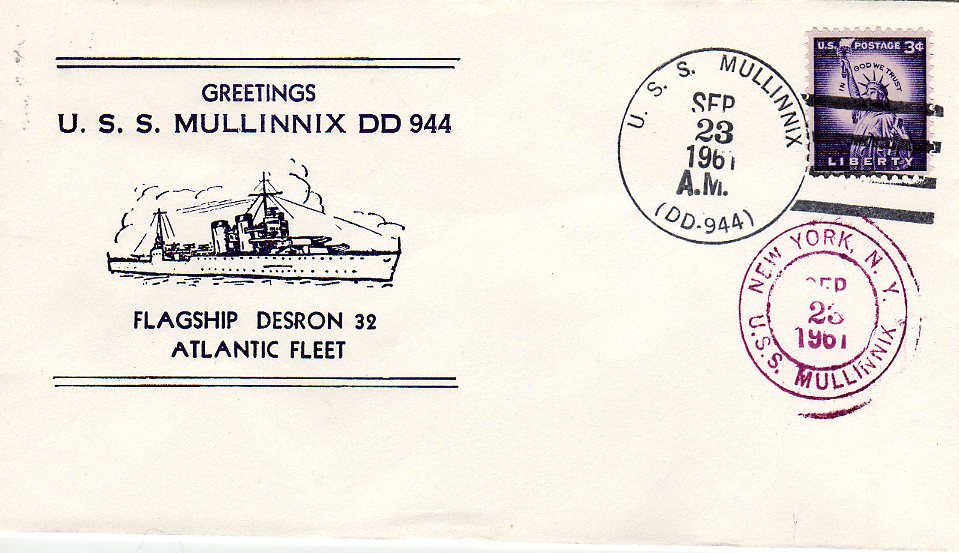
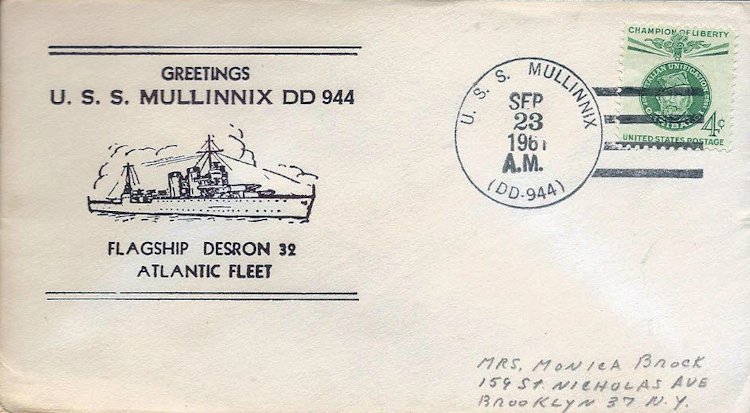
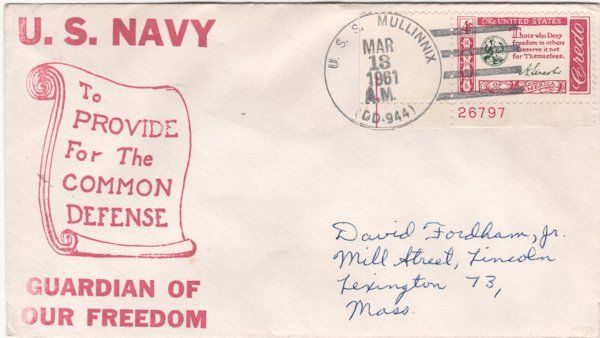
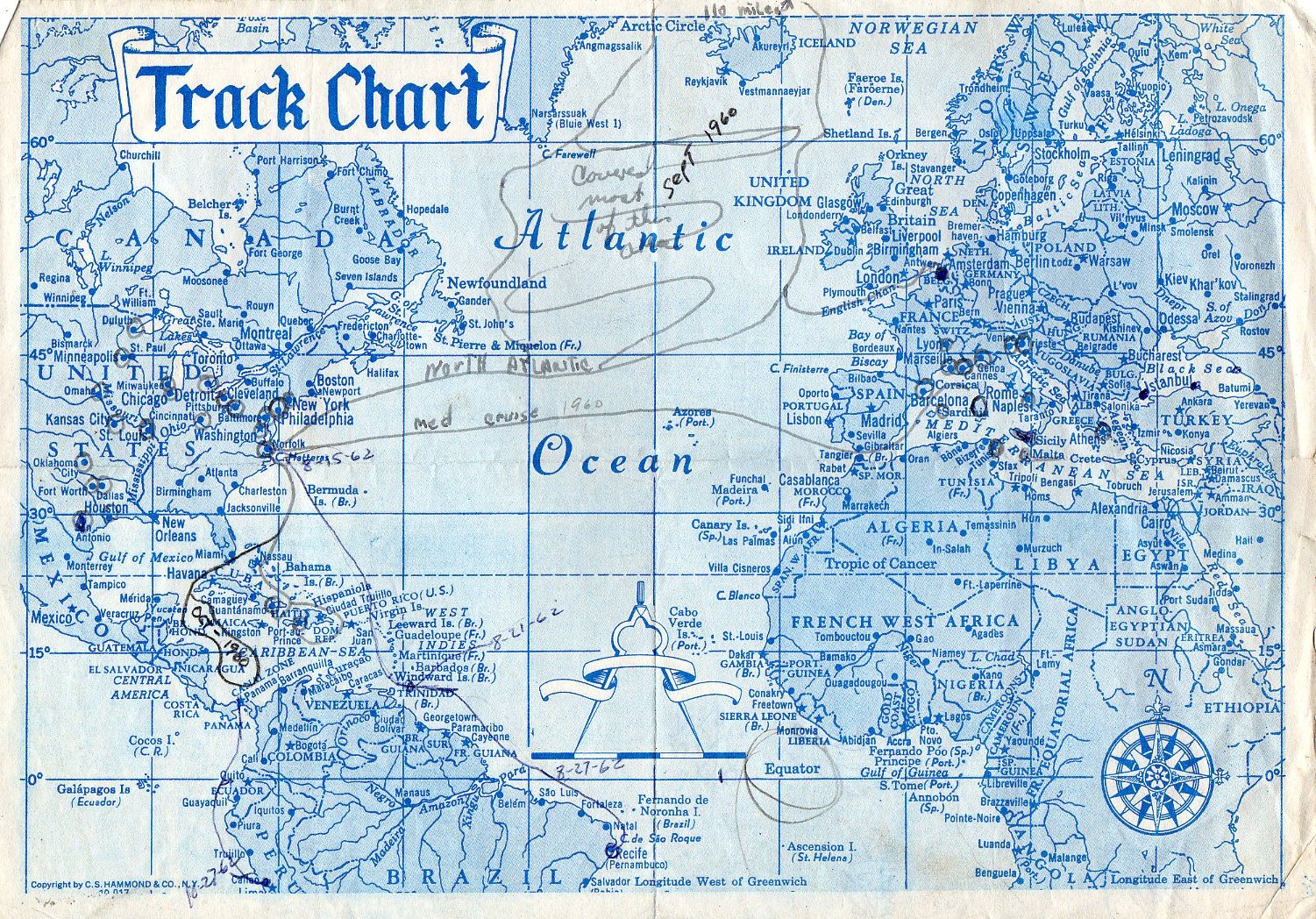
Mullinnix Track Chart for 1960-62. Courtesy Robert Hall
GO TO Key West 1961
GO TO Liberty Call Naples Italy 1961
GO TO Liberty Call Cannes France 1961
GO TO Liberty Call Eregli, Turkey 1961
GO TO Liberty Call Samson, Turkey 1961
GO TO Liberty Call Istanbul, Turkey 1961
GO TO Liberty Call Malta 1961
GO TO Liberty Call Rota, Spain 1961
GO TO Liberty Call Taormina, Sicily 1961
GO TO Liberty Call Athens, Greece 1961
GO TO Liberty Call Cannes, France 1961
GO TO Liberty Call Palermo, Sicily 1961
GO TO Liberty Call Gaeta, Italy 1961
GO TO Liberty Call Naples, Italy (Return Trip) 1961
GO TO Liberty Call St. Jean, France 1961
Back to 1960 North Atantic Cruise
Back to Ship History
Home
© 2003 by Frank Wood, All rights reserved
 1961
1961
 1961
1961














